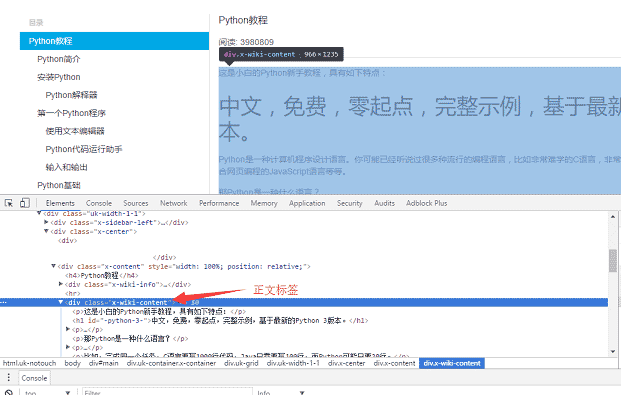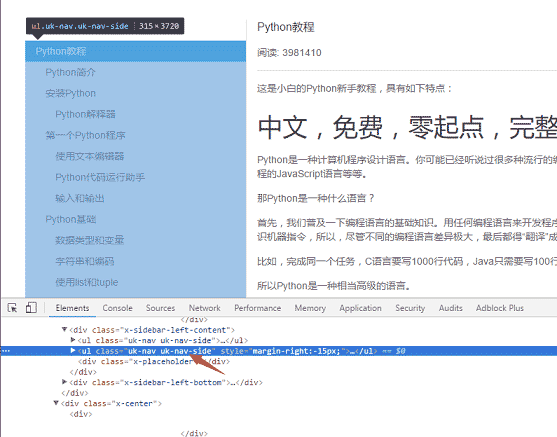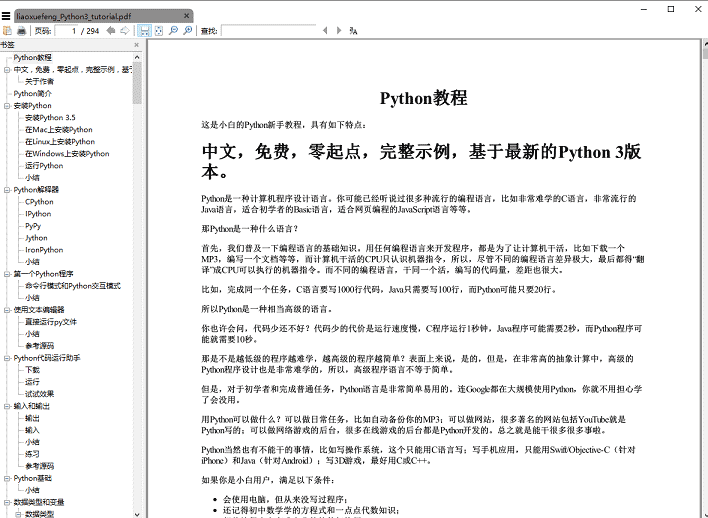 Backend Development
Backend Development
 Python Tutorial
Python Tutorial
 Python crawler implementation tutorial converted into PDF e-book
Python crawler implementation tutorial converted into PDF e-book
Python crawler implementation tutorial converted into PDF e-book
This article shares with you the method and code of using python crawler to convert "Liao Xuefeng's Python Tutorial" into PDF. Friends in need can refer to it.
It seems that there is no easier way to write a crawler than using Python. It's appropriate. There are so many crawler tools provided by the Python community that you will be dazzled. With various libraries that can be used directly, you can write a crawler in minutes. Today I am thinking about writing a crawler and crawling down Liao Xuefeng's Python tutorial. Create a PDF e-book for everyone to read offline.
Before we start writing the crawler, let’s first analyze the page structure of the website 1. The left side of the web page is the directory outline of the tutorial. Each URL corresponds to an article on the right. The upper right side is the article’s The title, in the middle is the text part of the article. The text content is the focus of our concern. The data we want to crawl is the text part of all web pages. Below is the user's comment area. The comment area is of no use to us, so we can ignore it.

Tool preparation
After you have figured out the basic structure of the website, you can start preparing the tool kits that the crawler depends on. requests and beautifulsoup are two major artifacts of crawlers, reuqests is used for network requests, and beautifulsoup is used to operate html data. With these two shuttles, we can work quickly. We don't need crawler frameworks like scrapy. Using it in small programs is like killing a chicken with a sledgehammer. In addition, since you are converting html files to pdf, you must also have corresponding library support. wkhtmltopdf is a very good tool that can convert html to pdf suitable for multiple platforms. pdfkit is the Python package of wkhtmltopdf. First install the following dependency packages,
Then install wkhtmltopdf
pip install requests pip install beautifulsoup pip install pdfkit
Install wkhtmltopdf
For the Windows platform, download the stable version directly from the wkhtmltopdf official website 2 and install it. After the installation is completed, add the execution path of the program to the system environment $PATH variable. Otherwise, pdfkit cannot find wkhtmltopdf and the error "No wkhtmltopdf executable found" will appear. Ubuntu and CentOS can be installed directly using the command line
$ sudo apt-get install wkhtmltopdf # ubuntu $ sudo yum intsall wkhtmltopdf # centos
Crawler implementation
After everything is ready, you can go Code, but I still need to sort out my thoughts before writing code. The purpose of the program is to save the html text parts corresponding to all URLs locally, and then use pdfkit to convert these files into a pdf file. Let's split the task. First, save the html text corresponding to a certain URL locally, and then find all URLs and perform the same operation.
Use the Chrome browser to find the tag in the body part of the page, and press F12 to find the p tag corresponding to the body: <p >, where p is the body content of the web page. After using requests to load the entire page locally, you can use beautifulsoup to operate the HTML dom element to extract the text content.

The specific implementation code is as follows: Use the soup.find_all function to find the text tag, and then save the content of the text part to the a.html file.
def parse_url_to_html(url):
response = requests.get(url)
soup = BeautifulSoup(response.content, "html5lib")
body = soup.find_all(class_="x-wiki-content")[0]
html = str(body)
with open("a.html", 'wb') as f:
f.write(html)The second step is to parse out all the URLs on the left side of the page. Use the same method to find the left menu label <ul >

def get_url_list():
"""
获取所有URL目录列表
"""
response = requests.get("http://www.liaoxuefeng.com/wiki/0014316089557264a6b348958f449949df42a6d3a2e542c000")
soup = BeautifulSoup(response.content, "html5lib")
menu_tag = soup.find_all(class_="uk-nav uk-nav-side")[1]
urls = []
for li in menu_tag.find_all("li"):
url = "http://www.liaoxuefeng.com" + li.a.get('href')
urls.append(url)
return urlsdef save_pdf(htmls):
"""
把所有html文件转换成pdf文件
"""
options = {
'page-size': 'Letter',
'encoding': "UTF-8",
'custom-header': [
('Accept-Encoding', 'gzip')
]
}
pdfkit.from_file(htmls, file_name, options=options)
Summary
The total code amount adds up to less than 50 lines, however, Wait a minute, in fact, the code given above omits some details. For example, how to get the title of the article. The img tag of the text content uses a relative path. If you want to display the image normally in the PDF, you need to change the relative path to an absolute path. , and the saved temporary html files must be deletedFor more python crawler implementation tutorials converted into PDF e-books, please pay attention to the PHP Chinese website!

Hot AI Tools

Undresser.AI Undress
AI-powered app for creating realistic nude photos

AI Clothes Remover
Online AI tool for removing clothes from photos.

Undress AI Tool
Undress images for free

Clothoff.io
AI clothes remover

Video Face Swap
Swap faces in any video effortlessly with our completely free AI face swap tool!

Hot Article

Hot Tools

Notepad++7.3.1
Easy-to-use and free code editor

SublimeText3 Chinese version
Chinese version, very easy to use

Zend Studio 13.0.1
Powerful PHP integrated development environment

Dreamweaver CS6
Visual web development tools

SublimeText3 Mac version
God-level code editing software (SublimeText3)

Hot Topics
 How to solve the permissions problem encountered when viewing Python version in Linux terminal?
Apr 01, 2025 pm 05:09 PM
How to solve the permissions problem encountered when viewing Python version in Linux terminal?
Apr 01, 2025 pm 05:09 PM
Solution to permission issues when viewing Python version in Linux terminal When you try to view Python version in Linux terminal, enter python...
 How to avoid being detected by the browser when using Fiddler Everywhere for man-in-the-middle reading?
Apr 02, 2025 am 07:15 AM
How to avoid being detected by the browser when using Fiddler Everywhere for man-in-the-middle reading?
Apr 02, 2025 am 07:15 AM
How to avoid being detected when using FiddlerEverywhere for man-in-the-middle readings When you use FiddlerEverywhere...
 How to efficiently copy the entire column of one DataFrame into another DataFrame with different structures in Python?
Apr 01, 2025 pm 11:15 PM
How to efficiently copy the entire column of one DataFrame into another DataFrame with different structures in Python?
Apr 01, 2025 pm 11:15 PM
When using Python's pandas library, how to copy whole columns between two DataFrames with different structures is a common problem. Suppose we have two Dats...
 How to teach computer novice programming basics in project and problem-driven methods within 10 hours?
Apr 02, 2025 am 07:18 AM
How to teach computer novice programming basics in project and problem-driven methods within 10 hours?
Apr 02, 2025 am 07:18 AM
How to teach computer novice programming basics within 10 hours? If you only have 10 hours to teach computer novice some programming knowledge, what would you choose to teach...
 How does Uvicorn continuously listen for HTTP requests without serving_forever()?
Apr 01, 2025 pm 10:51 PM
How does Uvicorn continuously listen for HTTP requests without serving_forever()?
Apr 01, 2025 pm 10:51 PM
How does Uvicorn continuously listen for HTTP requests? Uvicorn is a lightweight web server based on ASGI. One of its core functions is to listen for HTTP requests and proceed...
 How to handle comma-separated list query parameters in FastAPI?
Apr 02, 2025 am 06:51 AM
How to handle comma-separated list query parameters in FastAPI?
Apr 02, 2025 am 06:51 AM
Fastapi ...
 How to solve permission issues when using python --version command in Linux terminal?
Apr 02, 2025 am 06:36 AM
How to solve permission issues when using python --version command in Linux terminal?
Apr 02, 2025 am 06:36 AM
Using python in Linux terminal...
 How to get news data bypassing Investing.com's anti-crawler mechanism?
Apr 02, 2025 am 07:03 AM
How to get news data bypassing Investing.com's anti-crawler mechanism?
Apr 02, 2025 am 07:03 AM
Understanding the anti-crawling strategy of Investing.com Many people often try to crawl news data from Investing.com (https://cn.investing.com/news/latest-news)...





